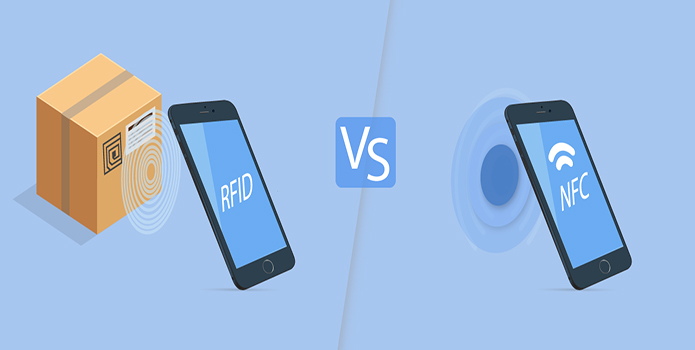The primary difference between RFID and NFC is that NFC works only with short distances (usually less than 10 cm), and it can be powered by capacitive energy transfer.
On the other hand, RFID uses the frequency of 125 kHz/13.56 MHz and requires a power source (battery or induction coil). It offers a maximum range of 100 meters.
Besides these differences, the technologies are pretty similar. This article gives an in-depth comparison between NFC and RFID.
RFIDとは?
RFID (Radio Frequency Identification) is a wireless non-contact technology that uses electromagnetic fields to transfer data from the Tag (transponder) to the Reader (interrogator).
The two main components of an RFID system are a tag and a reader device, each having an antenna. The transmission medium is the air interface.
It works at very high frequencies (125 kHz/13.56 MHz). As such, it allows large amounts of data to be transferred quickly between two transponders or between a transponder and a reader.
What are the Applications of RFID?
RFIDの用途はたくさんあります。産業プラントや工場など、さまざまな分野でアクセスを調整および制御するために使用できます。このように、これらのタグは、原材料と最終製品の使用を監視することで、産業プロセスの生産性を向上させ、廃棄物を減らすことができます。
また、港や空港の商用トラックやコンテナなどの資産の管理と監視にも役立ちます。これにより、盗難や誤った取り扱いによる損失を回避できます。
たとえば、会社が複数の倉庫を持っている場合、各倉庫の入り口に RFID リーダーを設置するだけで、どこにいても商品を見つけることができます。
RFID 技術は、次のような他の多くの分野でも使用できます。
- 識別とアクセス制御
- 車両追跡
- 動物/ペットの追跡、
- 決済システム(クレジットカードとの統合)と携帯電話
NFCとは?
NFC (Near field communication) is a wireless communication technology that allows two electronic devices closely placed (up to 4 cm) to establish communication and exchange data.
It is related to RFID but it works at lower frequencies (13.56 MHz). They allow large amounts of data to be transferred quickly between two transponders almost simultaneously.
NFC is comparable to Bluetooth, Infrared (IR), and Wireless LAN standards. Although each of these technologies has its protocol standard, they all establish communication using electromagnetic fields.
This technology requires short-range, so it is used to create wireless connections between small portable devices such as mobile phones or tablets.
What are NFC Tags?
An NFC tag contains information that different applications can access – usually through an NFC Service ID assigned by the manufacturer, depending on what service this tag will offer.
They have an NFC chip and an antenna embedded in a label or printed directly on a surface. The tag can be read from up to 20 cm (7.9 in) away by an active NFC device such as modern smartphones.
What are the Applications of NFC?
NFC には、スマートフォン間のファイル転送、支払いシステム、公共交通機関の発券、接触アクセス制御カードなど、いくつかのアプリケーションがあります。
さらに、高速データ転送のために、NFC リーダーを特定の場所に固定することができます。その一例が ATM で、クレジット カードを読み取り機にかざして、口座番号、有効期限、セキュリティ コードなどの有用な情報を読み取る必要があります。
このように、銀行の詳細を保存している NFC デバイス (ATM) にアクセスしない限り、誰もあなたのパスワードや銀行口座を支払い中に盗むことができないため、オンラインでの購入は安全です。
別 NFC タグのアプリケーション 広告にあります。多くの企業がメッセージを広めたいと考えていますが、誰もがテレビ広告を購入するのに十分な資金を持っているわけではありません。これらの企業は、NFC タグが埋め込まれた会社のロゴを含む特別なアイテムを作成します。そのため、誰かが NFC 対応の携帯電話を持って近くを歩くと、タグがスキャンされ、メッセージがポップアップ表示されます。
NFC タグ デバイスでアプリケーションや特定のアクションを起動するためにも使用できます。公共の場所で、携帯電話を使用せず、リーダーにタップするように求められている場合に、これが実際に行われているのを見たことがあるかもしれません。
その一例が Google ウォレットで、携帯電話を NFC リーダーにかざすだけでオンライン購入できます。このアクションにより、Google ウォレットが起動され、トランザクションを完了するために必要なデータが転送されます。
RFID vs. NFC – What is The Difference?
These technologies work on the same principle: sending and receiving data without any physical contact. While their speeds are very close, RFID is faster for a wide read range while NFC works in a smaller area.
Both RFID and NFC do not require a direct line of sight. As such, you can read the tags from whichever angle you find convenient. This feature makes the tag more reliable and faster compared to barcodes.
However, there are a few differences between RFID and NFC, including:
- Frequency of Operation. NFC operates only at 13.56 MHz while RFID can operate within a frequency range of 134.2 kHz to over 900 MHz.
- 範囲を読み取ります。 NFC operates optimally when the reader and the tags are a maximum of 10 cm away from each other. This short read range limits NFC to data exchange, contactless payments, and proximity cards. On the other hand, RFID tags can have a read range of up to 100 meters, thus making them ideal for tracking.
- Memory. RFID tags have a larger memory capacity than NFC. The feature makes them useful where you need to store massive amounts of data. Most RFID tags are not writable so it will be hard to change the data on there without erasing everything and writing it again. However, you can get one with write/read abilities.
- Functionality. RFID deals particularly with identification while NFC deals with communication. RFID is ideal for processing large amounts of data within a short time.
Both NFC and RFID are highly reliable. However, you should define your needs before you settle for one. If you need one for identification and access control, then we recommend RFID. If you need one for communication and data exchange, then you should choose NFC.


